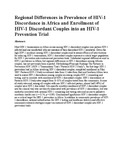Regional Differences in Prevalence of HIV-1 Discordance in Africa and Enrollment of HIV-1 Discordant Couples into an HIV-1 Prevention Trial

Date
2008Author
Lingappa, Jairam R
Lambdin, Barrot
Bukusi, EA
Ngure, Kenneth
Kavuma, Linda
Inambao, Mubiana
Kanweka, William
Allen, Susan
Kiarie, James N
Makhema, Joseph
et al
Type
ArticleLanguage
enMetadata
Show full item recordAbstract
Background
Most HIV-1 transmission in Africa occurs among HIV-1-discordant couples (one partner HIV-1 infected and one uninfected) who are unaware of their discordant HIV-1 serostatus. Given the high HIV-1 incidence among HIV-1 discordant couples and to assess efficacy of interventions for reducing HIV-1 transmission, HIV-1 discordant couples represent a critical target population for HIV-1 prevention interventions and prevention trials. Substantial regional differences exist in HIV-1 prevalence in Africa, but regional differences in HIV-1 discordance among African couples, has not previously been reported.
Methodology/Principal Findings
The Partners in Prevention HSV-2/HIV-1 Transmission Trial (“Partners HSV-2 Study”), the first large HIV-1 prevention trial in Africa involving HIV-1 discordant couples, completed enrollment in May 2007. Partners HSV-2 Study recruitment data from 12 sites from East and Southern Africa were used to assess HIV-1 discordance among couples accessing couples HIV-1 counseling and testing, and to correlate with enrollment of HIV-1 discordant couples. HIV-1 discordance at Partners HSV-2 Study sites ranged from 8–31% of couples tested from the community. Across all study sites and, among all couples with one HIV-1 infected partner, almost half (49%) of couples were HIV-1 discordant. Site-specific monthly enrollment of HIV-1 discordant couples into the clinical trial was not directly associated with prevalence of HIV-1 discordance, but was modestly correlated with national HIV-1 counseling and testing rates and access to palliative care/basic health care (r = 0.74, p = 0.09).
Conclusions/Significance
HIV-1 discordant couples are a critical target for HIV-1 prevention in Africa. In addition to community prevalence of HIV-1 discordance, national infrastructure for HIV-1 testing and healthcare delivery and effective community outreach strategies impact recruitment of HIV-1 discordant couples into HIV-1 prevention trials.
URI
http://www.ncbi.nlm.nih.gov/pubmed/18183292http://erepository.uonbi.ac.ke:8080/xmlui/handle/123456789/19926
http://www.ncbi.nlm.nih.gov/pmc/articles/PMC2156103/
Citation
PLoS ONE. 2008; 3(1): e1411.Publisher
Department of Obstetrics and Gynecology
Description
Full text
Collections
- Faculty of Health Sciences (FHS) [10378]
- Journal Articles [329]
